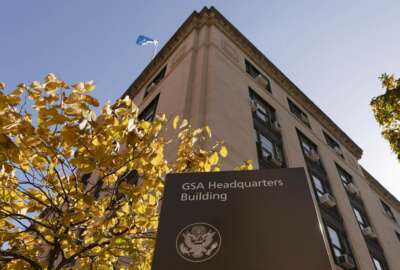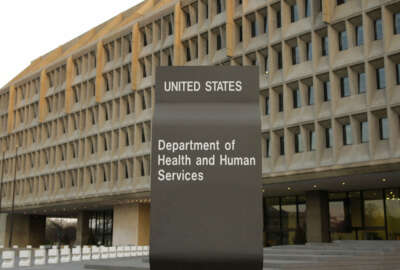

What promises to be a long accounting for the federal response to the pandemic, it's already underway.
Best listening experience is on Chrome, Firefox or Safari. Subscribe to Federal Drive’s daily audio interviews on Apple Podcasts or PodcastOne.
What promises to be a long accounting for the federal response to the pandemic, it’s already underway. One agency that was called to respond early is FEMA, the Federal Emergency Management Agency. A recent report from the Homeland Security Office of Inspector General found a mixed bag. The DHS deputy inspector general for audits, Bruce Miller, spoke to the Federal Drive with Tom Temin.
Interview transcript:
Tom Temin: Mr. Miller, good to have you on.
Bruce Miller: Hey, it’s great to be here, Tom. I really appreciate the opportunity.
Tom Temin: And let’s begin with what the agency was called to do early in the pandemic. I mean, you look back to the early parts of 2020, when this all kind of hit the country, correct?
Bruce Miller: That is correct. And before I jump into FEMA’s specific response, let me say that it’s noteworthy to mention that, you know, we purposefully started this audit very, very early on in the pandemic. And FEMA began implementing corrective actions immediately and improving processes and system information issues in real time. And we see real value when we have the opportunity to impact something on the front end. But back to FEMA’s specific response, you know, at the onset, while Health and Human Services was the lead federal agency, FEMA provided significant logistical support, such as interagency coordination, information sharing and coordination through its regional response coordination centers. Then in March 2020, the president issued emergency declarations for all states and territories. And so FEMA took on its Stafford Act responsibilities to prepare for, protect against and respond to the pandemic as it would during other natural disasters. The big difference here, Tom, though FEMA has never had a natural disaster affect all 56 states and territories at the same time, this one certainly did. So it was an absolutely unprecedented challenge for FEMA. And despite some of the challenges we identified, they did ultimately help facilitate the shipment of personal protective equipment and ventilators throughout the country.
Tom Temin: Yes, and you point to something, I think that’s important. And that is they were able to do so in collaboration with a totally different department, HHS, that was the lead on much of this. I mean, often it takes federal agencies two years to do a minor memorandum of understanding.
Bruce Miller: Yeah, that’s correct. And I think FEMA’s experience with the Stafford Act, and having to coordinate with multiple federal agencies through natural disasters really assisted them in helping out with this pandemic.
Tom Temin: And because of the newer materials and the oddball things relative to other disasters that they had to deliver, what did you find with respect to FEMA’s preparation and the kind of support systems they had in place for something like this?
Bruce Miller: Yeah, so FEMA had to fulfill, you know, different requests. You know, we talked about managing and coordination, and to do that they activated the National Response Coordination Center, and their regional response coordination centers, which really helped the federal government identify the stakeholders that needed to be involved. They also established a unified coordination group, and they ensured that all levels of government worked together in unity. As far as specific systems, FEMA used its web emergency operations center system to fulfill resource requests. And this is the system that FEMA uses for natural disasters. States, territories, tribes and other federal agencies can access that system to request federal assistance for resources or personnel support. And again, during most disasters, you know, you’re talking about a small number of users in a geographic area. During the pandemic, it was all states and territories making requests for resources.
Tom Temin: Yeah, and that’s really something that you point out that’s important. And that is, typically FEMA responses are localized, or regionalized, maybe a couple of counties, that type of thing. But this exposed the entire nation, and therefore the supply system for the nation seem to lock up. As we all learned, we’re still living with it in some sense. And so maybe we should give FEMA credit for discovering a flaw in the national distribution system of these types of goods that probably no one anticipated.
Bruce Miller: Yeah, I think that’s a very fair commentary, Tom. And, again, it’s a good thing that they had a system of record that all 56 states and territories, you know, could make requests to begin with. So I would agree,
Tom Temin: And what were some of their challenges in this? What could they have done more sharply, do you think?
Bruce Miller: So, as it relates to the distribution of ventilators, Tom, FEMA developed and communicated, for that matter, a very standardized process for allocating a limited supply of ventilators. So stakeholder confusion, or questions on, you know, did they request the right way, are they going to get what they requested, that actually worked very well. However, they didn’t have a similar process for personal protective equipment, and the volume of requests for masks, gloves, gowns, other gear used to protect frontline workers did expose challenges with the system. It just really wasn’t suitable for clearly identifying different types of resources, such as different sizes, materials for gloves or types of masks initially. However, FEMA found out that issue very early on and was able to correct it very early on during our audit. We did also find some systemic issues with validation processes that would have prevented potential errors or incomplete fields. Specifically, what we really found was missing requesters. So you know, who is making this personal protective equipment request? Missing type of equipment wasn’t always included, and then duplicate supply request entries. And what this really did is it made it difficult for the national and the regional centers to make well informed decisions. And it did contribute to some stakeholder confusion about FEMA’s adjudication and allocation processes.
Tom Temin: We’re speaking with Bruce Miller, deputy inspector general for audits at the Homeland Security Department. So are you saying this is a problem with their information system design that those fields or that data wasn’t collected? Or was it some other problem?
Bruce Miller: So it was a couple of things. It was the validation controls on the front end, for instance, that didn’t prevent duplicate requests. And you know, in a situation like this, if you’ve got duplicate requests, and you have such limited resources, you know, you’re really putting a strain on whether or not you can get the right resources to the right folks. So there were some internal control issues on the front end. The second issue that we really identified is there were just more people accessing this system again, you know, because you have all the states and territories, so they had so many new and returning users, that they just weren’t really terribly familiar with the system. And with the time crunch, it was very difficult to get those users trained very early on. So that definitely created to some of the issues as well.
Tom Temin: And I imagine some of the requesters panicked and maybe sent in the request three times, if we think we need 10,000 gloves, well, let’s get 30,000. Because there’s only 30,000 in the country or something like that.
Bruce Miller: That’s very possible. You know, we didn’t dig into each individual circumstance of those duplicate requests. But in theory, I would say that that’s probably very good.
Tom Temin: And have things pretty much settled down to normal at this point? Is FEMA kind of backed out of this whole process? Because for those supplies and most of the ventilators, it turns out they weren’t actually needed, I think we found out later on. But for all the rest of the supplies, is that kind of normalized at this point?
Bruce Miller: Yeah. So we haven’t done a verification review at this point to follow up on our initial work. But in our communications with FEMA, we believe that to be the case, yes.
Tom Temin: All right. So exposed weaknesses, your study exposed weaknesses when there’s a kind of a mass, sudden high demand widespread event. What were your recommendations for being prepared for the next peak?
Bruce Miller: We ended up making three recommendations in this report. And the first was specifically to the system issues, and that was to develop additional internal controls, and to ensure new users receive formal training. And this will help improve the data reliability in the system moving forward. The second recommendation was to formally document processes and procedures for making informed and consistent resource allocation decisions. This really helps get to that stakeholder confusion. They can completely understand the adjudication decisions. And then finally, with this being an unprecedented event for a pandemic. You know, we recommended FEMA work with health and human services to issue clarifying guidance defining agencies’ roles and responsibilities under Stafford Act declarations specific to pandemic-related response.
Tom Temin: So if you add all those up — internal controls improvement, better training, better documentation and guidance and so forth for the interagency aspect — that’s very different from saying, well, you made a stockpile 10 million masks and 500 million gloves, as opposed to, say, here’s what you need to be resilient the next time this could happen. Is that fair way to characterize it?
Bruce Miller: Yes, Tom. That’s a very fair way.
Tom Temin: And what was FEMA’s reaction so far?
Bruce Miller: So FEMA concurred with all of our recommendations, Tom. Right now they plan to address the data reliability issues. They’re developing a plan to address training gaps. They also plan to analyze and address how staffing requirements were impacted, specific to those new users by the expanded mission set. They’re also, you know, to improve resource allocation processes, FEMA is going to issue updated guidance. Specifically, they’re incorporating COVID-19 lessons learned and best practices and their revised biological incident annex and the pandemic crisis action plan.
Tom Temin: So now the challenge is making sure all of that material is available and current should there — we hope not — but should there be a next time?
Bruce Miller: Absolutely, Tom. Yes, there’ll be very much better prepared in our opinion.
Tom Temin: Bruce Miller is Deputy Inspector General for audits at the Homeland Security Department. Thanks so much for joining me.
Bruce Miller: Hey, thanks, Tom. Really appreciate the opportunity.
Copyright © 2025 Federal News Network. All rights reserved. This website is not intended for users located within the European Economic Area.
Tom Temin is host of the Federal Drive and has been providing insight on federal technology and management issues for more than 30 years.
Follow @tteminWFED


